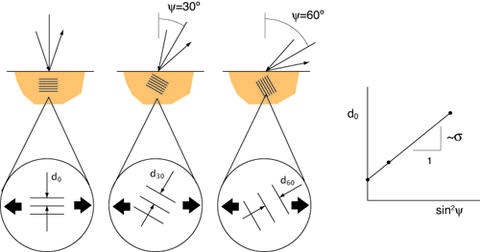Summary
Diffraction-based stress measurements are powerful techniques that can be used to measure the residual and applied stresses in a material under loading . This method measures the spacing between layers of atoms and tracks the spacing as it expands or contracts in response to force. The NIST Center for Automotive Lightweighting (NCAL) employs this technique for stress measurements that are difficult to determine from simple force-over-area calculations such as those in multiaxial deformation, uniaxial testing beyond uniform deformation, or inside an individual crystallite.
Description
Using X-ray diffraction (XRD) techniques one can measure the full stress tensor just inside the surface of a sheet metal specimen under applied loading. This permits the measurement of biaxial stress states resulting from directly applied deformation (see NCAL: Multiaxial Material Performance) or resulting from features such as a hole or localized neck. Measurements can be made even when the test method cannot measure the stress directly, due to unquantifiable friction (such as in the Forming Limit Press), complex specimen designs (cruciform testing and octostrain testing), and/or highly anisotropic sheet materials that have strong crystallographic texture owing to rolling mill processing.
XRD is commonly used to measure a material’s crystal structure, crystal lattice orientation, and the spacing of the lattice planes. NCAL’s XRD systems are designed to measure the spacing of one or two specifically selected lattice plane reflections for a given material. By tilting the measurement system from the normal direction of the sheet toward the direction of loading the distribution of strains can be measured and used to derive the full stress tensor just inside the sheet surface. In addition to the work in NCAL, we also have a close collaboration with the staff who operate the neutron diffractometer at NIST Center for Neutron Research (NCNR) beamline BT-8.

Major Accomplishments
Papers, software and data grouped by topic area are listed below or in the Related Publications section. Most recent work is at the top of the list.

